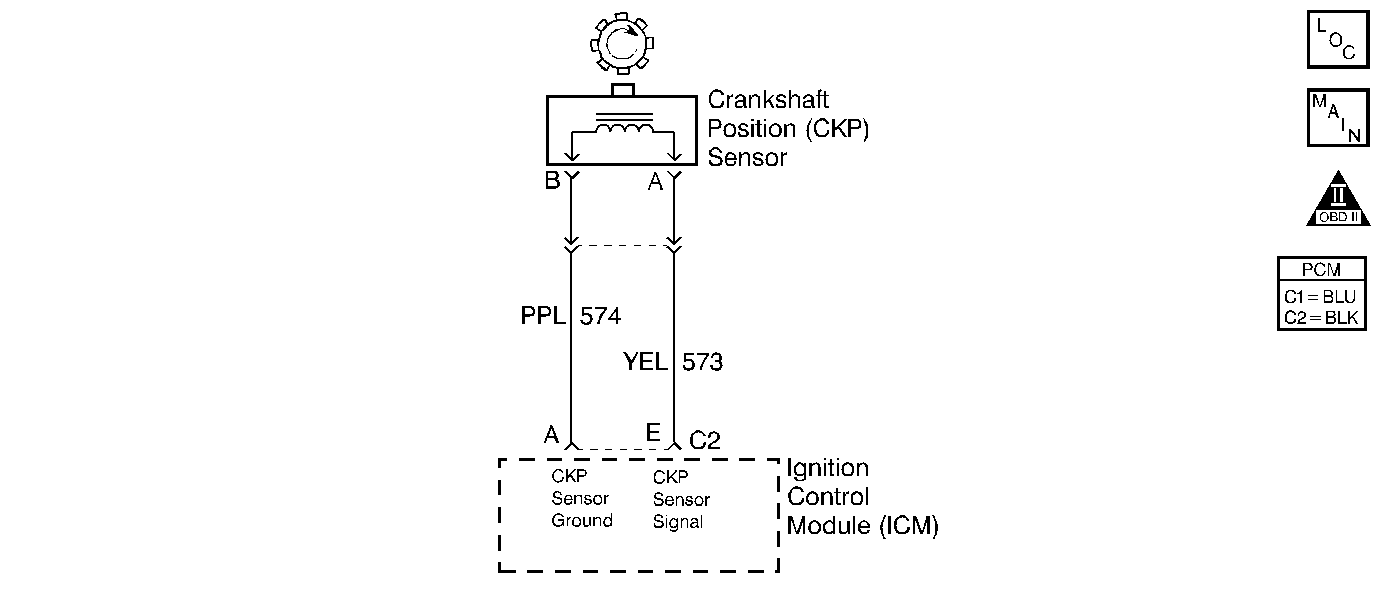
Circuit Description
The electronic ignition control module (ICM) sends a reference signal to the powertrain control module (PCM) seven times per crankshaft revolution to indicate crankshaft position and RPM so that the PCM can determine when to pulse the ignition coils and control the ignition timing. This signal is called medium resolution, 7X reference, because it occurs seven times per crankshaft revolution. The ICM applies 5 volts through the 7X reference circuit and, in effect, switches this circuit to ground for a very short period of time. The seventh pulse is the sync pulse and is used for crankshaft position reference.
Conditions For Setting The DTC
The 7X resync counter goes greater than 15 within 4 minutes and 15 seconds.
Action Taken When the DTC Sets
| • | The malfunction indicator lamp (MIL) will illuminate. |
| • | The PCM will record the operating conditions at the time that the diagnostic fails. The Freeze Frame and Failure Records buffers will store this information. |
| • | A history DTC stores. |
Conditions for Clearing the MIL/DTC
| • | The malfunction indicator lamp (MIL) will turn OFF after 3 consecutive ignition cycles in which the diagnostic runs without a fault. |
| • | A history DTC will clear after 40 consecutive warm up cycles without a fault. |
| • | Use a scan tool to clear the DTCs. |
Diagnostic Aids
| • | If the complaint was Cranks But Will Not Run, the DTC P0335 may set when attempting to start the engine more than 15 times and the ignition is not turned OFF between the attempts. |
| • | A rubbed through wire insulation or a poor connection may cause an intermittent problem. |
| • | A defective reluctor wheel can result in an intermittent. Remove the crankshaft sensor and inspect the reflector wheel through the hole. Check the porosity and condition of the wheel. |
Test Description
Number(s) below refer to the step number(s) on the Diagnostic Table.
-
The Powertrain OBD System Check prompts the technician to complete some basic checks and store the freeze frame and failure records data on the scan tool if applicable. This creates an electronic copy of the data taken when the malfunction occurred. The information is then stored on the scan tool for later reference.
-
This step determines if the PCM recognizes a problem. If the DTC does not reset at this point, the problem may be intermittent.
-
When a Med. Resolution Resync occurs, engine stumble should also occur. If a component connection or wire is malfunctioning, an engine stumble or a medium resolution resync may be induced by wiggling the circuit or connector.
-
Operating a malfunctioning non-engine related electronic components may emit the Electromagnetic Interference (EMI) which may cause a resync. This step will determine if the medium resolution resync's are being caused by an outside source.
-
Any circuitry, that is suspected as causing the complaint, should be thoroughly checked for backed out terminals, improper mating, broken locks, improperly formed or damaged terminals, poor terminal to wiring connections or physical damage to the wiring harness.
-
An intermittent problem may be caused by a rubbed through wire insulation or a poor connection.
Step | Action | Value(s) | Yes | No |
|---|---|---|---|---|
Was the Powertrain On-Board Diagnostic (OBD) System Check performed? | -- | |||
2 | Will engine start? | -- | ||
Did the MIL illuminate? | 5 | |||
|
Caution: Avoid contact with moving parts and hot surfaces while working around a running engine in order to prevent physical injury. With the engine running, wiggle the electrical connectors of the PCM, ICM and the CKP sensors and related circuits, while listening for engine stumble. Does the engine stumble? | -- | |||
Operate any non-engine related electronic component on the vehicle. Does the Med. Resolution Resync Cntr on the scan tool resync while operating any non-engine related electronic components? | -- | |||
Check for a poor connection or replace the terminal in the circuit which caused the engine to stumble and repair as necessary Is the action complete? | -- | -- | ||
7 | Did the MIL illuminate in Step 3? | -- | ||
Check the wiring to the PCM, ICM, and CKP sensor for rubbed through wire insulation or for being pinched and repair as necessary. IWas a repair necessary? | -- | |||
9 | Repair the circuitry of the malfunctioning or interfering component. Is the action complete? | -- | -- | |
10 |
Did the MIL illuminate? | 5 | ||
11 |
Did the MIL illuminate? | 5 | ||
12 |
Did the MIL illuminate? | 5 | Go to Diagnostic Aids | |
13 |
Does the scan tool indicate that this diagnostic has ran and passed? | -- | ||
14 | Check if any additional DTCs are set. Are any DTCs displayed that have not been diagnosed? | -- | Go to applicable DTC table | System OK |
